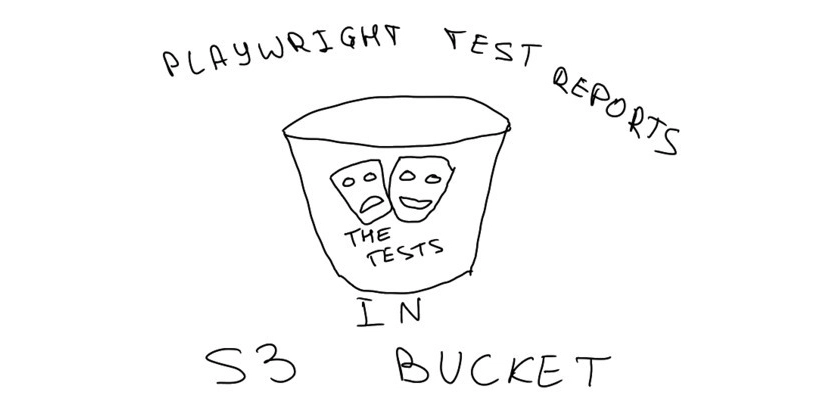CI/CD guide: store Playwright test results in AWS S3
Intro Modern software development is deeply intertwined with software testing. Unit tests, integration tests, end-to-end tests — without them, we would spend much more time fixing trivial bugs instead of actually developing software. One of the most complex test scenarios is end-to-end testing: it verifies real business functionality and replaces manual clicking with automated test suites. In my job, I've encountered a tool called Playwright for this purpose and was greatly impressed by its capabilities. You can program it to do all the things you do manually -- and run them automatically without needing to open a browser. It's no wonder someone took the time to transform such bloatware as a modern browser into something more automation-friendly. Amazing! The complication starts when these scenarios need to be integrated into the CI/CD pipeline. It's pretty simple when you trigger tests locally and then review the saved report in your browser. But what if you want to run tests in a centralized CI/CD tool and save the report for further review? And this is where S3 comes to save the day once again! GitHub Actions setup The first step in configuring automated tests in the CI/CD pipeline is quite simple and already covered in the Playwright documentation. The workflow configuration is pretty straightforward: name: Playwright Tests on: push: branches: [ main, master ] pull_request: branches: [ main, master ] jobs: test: timeout-minutes: 60 runs-on: ubuntu-latest steps: - uses: actions/checkout@v4 - uses: actions/setup-node@v4 with: node-version: lts/* - name: Install dependencies run: npm ci - name: Install Playwright Browsers run: npx playwright install --with-deps - name: Run Playwright tests run: npx playwright test - uses: actions/upload-artifact@v4 if: ${{ !cancelled() }} with: name: playwright-report path: playwright-report/ retention-days: 30 I just want to emphasize a few key points here. We must use Ubuntu as the base image because Playwright dependencies rely exclusively on Debian package distributions. This should not be an issue when running tests in the pipeline, but for local setups on RHEL-based distributions, it might introduce some fun challenges. Also, running tests on every pull request and push to main branches can be time-consuming, so it makes perfect sense to cache the bloated browser downloads (which are around 500 MB) and store them for a while. In the following example, we cache them for a day: - name: Get date id: date run: echo "date=$(date +%Y-%m-%d)" >> $GITHUB_OUTPUT - name: Cache Playwright browsers id: cache-playwright-browsers uses: actions/cache@v4 with: path: ~/.cache/ms-playwright key: playwright-browsers-${{ steps.date.outputs.date }} S3 bucket setup The first part of the configuration is done -- now let’s do something about those reports, right? Obviously, we need a bucket. So let’s create one. For the sake of simplicity, I’ll provide only the Terraform code here. # S3 bucket for e2e test reports resource "aws_s3_bucket" "e2e_test_reports" { bucket = "playwright-test-reports" } # Bucket ownership controls resource "aws_s3_bucket_ownership_controls" "e2e_test_reports" { bucket = aws_s3_bucket.e2e_test_reports.id rule { object_ownership = "BucketOwnerEnforced" } } # Lifecycle configuration for expiration after 30 days resource "aws_s3_bucket_lifecycle_configuration" "e2e_test_reports" { bucket = aws_s3_bucket.e2e_test_reports.id rule { id = "delete-30d" status = "Enabled" expiration { days = 30 } } } # Public access policy for the bucket resource "aws_s3_bucket_policy" "e2e_test_reports" { bucket = aws_s3_bucket.e2e_test_reports.id policy = data.aws_iam_policy_document.e2e_test_reports_public.json } # Public access block settings resource "aws_s3_bucket_public_access_block" "e2e_test_reports" { bucket = aws_s3_bucket.e2e_test_reports.id block_public_acls = false block_public_policy = false ignore_public_acls = false restrict_public_buckets = false } # Policy document for public read access data "aws_iam_policy_document" "e2e_test_reports_public" { statement { principals { type = "*" identifiers = ["*"] } actions = ["s3:GetObject"] resources = ["${aws_s3_bucket.e2e_test_reports.arn}/*"] } } As you can see, the configuration is pretty basic. We enable a lifecycle policy to delete files after 30 days, since there's rarely a need to keep old test reports. We also attach a fairly permissive bucket policy, allowing us to view report files directly in the browser without needing to log into the AWS Web Console. Finalizing the report publication After the preparation, we are now ready to run the tests and view the r

Intro
Modern software development is deeply intertwined with software testing. Unit tests, integration tests, end-to-end tests — without them, we would spend much more time fixing trivial bugs instead of actually developing software. One of the most complex test scenarios is end-to-end testing: it verifies real business functionality and replaces manual clicking with automated test suites.
In my job, I've encountered a tool called Playwright for this purpose and was greatly impressed by its capabilities. You can program it to do all the things you do manually -- and run them automatically without needing to open a browser. It's no wonder someone took the time to transform such bloatware as a modern browser into something more automation-friendly. Amazing!
The complication starts when these scenarios need to be integrated into the CI/CD pipeline. It's pretty simple when you trigger tests locally and then review the saved report in your browser. But what if you want to run tests in a centralized CI/CD tool and save the report for further review? And this is where S3 comes to save the day once again!
GitHub Actions setup
The first step in configuring automated tests in the CI/CD pipeline is quite simple and already covered in the Playwright documentation. The workflow configuration is pretty straightforward:
name: Playwright Tests
on:
push:
branches: [ main, master ]
pull_request:
branches: [ main, master ]
jobs:
test:
timeout-minutes: 60
runs-on: ubuntu-latest
steps:
- uses: actions/checkout@v4
- uses: actions/setup-node@v4
with:
node-version: lts/*
- name: Install dependencies
run: npm ci
- name: Install Playwright Browsers
run: npx playwright install --with-deps
- name: Run Playwright tests
run: npx playwright test
- uses: actions/upload-artifact@v4
if: ${{ !cancelled() }}
with:
name: playwright-report
path: playwright-report/
retention-days: 30
I just want to emphasize a few key points here.
We must use Ubuntu as the base image because Playwright dependencies rely exclusively on Debian package distributions. This should not be an issue when running tests in the pipeline, but for local setups on RHEL-based distributions, it might introduce some fun challenges.
Also, running tests on every pull request and push to main branches can be time-consuming, so it makes perfect sense to cache the bloated browser downloads (which are around 500 MB) and store them for a while. In the following example, we cache them for a day:
- name: Get date
id: date
run: echo "date=$(date +%Y-%m-%d)" >> $GITHUB_OUTPUT
- name: Cache Playwright browsers
id: cache-playwright-browsers
uses: actions/cache@v4
with:
path: ~/.cache/ms-playwright
key: playwright-browsers-${{ steps.date.outputs.date }}
S3 bucket setup
The first part of the configuration is done -- now let’s do something about those reports, right?
Obviously, we need a bucket. So let’s create one. For the sake of simplicity, I’ll provide only the Terraform code here.
# S3 bucket for e2e test reports
resource "aws_s3_bucket" "e2e_test_reports" {
bucket = "playwright-test-reports"
}
# Bucket ownership controls
resource "aws_s3_bucket_ownership_controls" "e2e_test_reports" {
bucket = aws_s3_bucket.e2e_test_reports.id
rule {
object_ownership = "BucketOwnerEnforced"
}
}
# Lifecycle configuration for expiration after 30 days
resource "aws_s3_bucket_lifecycle_configuration" "e2e_test_reports" {
bucket = aws_s3_bucket.e2e_test_reports.id
rule {
id = "delete-30d"
status = "Enabled"
expiration {
days = 30
}
}
}
# Public access policy for the bucket
resource "aws_s3_bucket_policy" "e2e_test_reports" {
bucket = aws_s3_bucket.e2e_test_reports.id
policy = data.aws_iam_policy_document.e2e_test_reports_public.json
}
# Public access block settings
resource "aws_s3_bucket_public_access_block" "e2e_test_reports" {
bucket = aws_s3_bucket.e2e_test_reports.id
block_public_acls = false
block_public_policy = false
ignore_public_acls = false
restrict_public_buckets = false
}
# Policy document for public read access
data "aws_iam_policy_document" "e2e_test_reports_public" {
statement {
principals {
type = "*"
identifiers = ["*"]
}
actions = ["s3:GetObject"]
resources = ["${aws_s3_bucket.e2e_test_reports.arn}/*"]
}
}
As you can see, the configuration is pretty basic. We enable a lifecycle policy to delete files after 30 days, since there's rarely a need to keep old test reports. We also attach a fairly permissive bucket policy, allowing us to view report files directly in the browser without needing to log into the AWS Web Console.
Finalizing the report publication
After the preparation, we are now ready to run the tests and view the reports directly in our browser.
To upload files from the GitHub Actions pipeline, we need to acquire AWS credentials. Here is the manual on how to configure OIDC in AWS for GitHub, which is supported by aws-actions/configure-aws-credentials@v4. To retrieve the necessary credentials properly, we provide additional permissions: id-token: write and contents: read.
Then we configure the test setup as usual, and at the end, we archive the resulting report in two places: GitHub Artifacts and S3. Since we previously created fairly open access to the files in our bucket, we add a layer of obscurity by including a random UUID string in the file path. This way, any malicious actor -- should they be determined to view our failing tests -- would have to deduce at least three variables: the random UUID (complex), the PR number (trivial), and the GitHub run ID (somewhat complex).
Let’s take a look at how the final GitHub Actions workflow looks.
name: Playwright Tests
on:
push:
branches: [ main, master ]
pull_request:
branches: [ main, master ]
jobs:
test:
timeout-minutes: 60
runs-on: ubuntu-latest
env:
BUCKET_NAME: 'playwright-test-reports'
AWS_REGION: 'eu-west-1'
AWS_ASSUMED_ROLE: 'arn:aws:iam::123456789012:role/github-actions-role'
permissions:
id-token: write
contents: read
steps:
- uses: actions/checkout@v4
- uses: actions/setup-node@v4
with:
node-version: lts/*
- name: Configure AWS credentials
uses: aws-actions/configure-aws-credentials@v4
with:
role-to-assume: ${{ env.AWS_ASSUMED_ROLE }}
role-session-name: 'github-actions'
aws-region: ${{ env.AWS_REGION }}
- id: date
run: echo "date=$(date +%Y-%m-%d)" >> $GITHUB_OUTPUT
- name: Install dependencies
run: npm ci
- name: Cache Playwright browsers
id: cache-playwright-browsers
uses: actions/cache@v4
with:
path: ~/.cache/ms-playwright
key: playwright-browsers-${{ steps.date.outputs.date }}
- name: Install Playwright browsers
if: steps.cache-playwright-browsers.outputs.cache-hit != 'true'
run: npx playwright install --with-deps
- name: Run Playwright tests
run: npx playwright test
- uses: actions/upload-artifact@v4
if: always()
with:
name: playwright-report
path: playwright-report/
retention-days: 30
- name: Upload Test Report to S3
if: always()
run: |
RANDOM_ID="$(uuidgen -r)"
aws s3 cp --recursive ./playwright-report/ s3://${{ env.BUCKET_NAME }}/${RANDOM_ID}/PR${{ github.event.pull_request.number }}/${{ github.run_id }}/
echo "Uploaded test report to S3: https://${{ env.BUCKET_NAME }}.s3.${{ env.AWS_REGION }}.amazonaws.com/${RANDOM_ID}/PR${{ github.event.pull_request.number }}/${{ github.run_id }}/index.html"
Of course, this solution is far from secure. To improve the safety of publishing test reports, we can use Signed URLs and serve those instead of direct links. Alternatively, we can modify the bucket policy to allow access only from specific IP addresses, such as your VPN. The possibilities are vast!




































































































































































![[The AI Show Episode 145]: OpenAI Releases o3 and o4-mini, AI Is Causing “Quiet Layoffs,” Executive Order on Youth AI Education & GPT-4o’s Controversial Update](https://www.marketingaiinstitute.com/hubfs/ep%20145%20cover.png)






























































































































![[DEALS] Microsoft 365: 1-Year Subscription (Family/Up to 6 Users) (23% off) & Other Deals Up To 98% Off – Offers End Soon!](https://www.javacodegeeks.com/wp-content/uploads/2012/12/jcg-logo.jpg)


![From Art School Drop-out to Microsoft Engineer with Shashi Lo [Podcast #170]](https://cdn.hashnode.com/res/hashnode/image/upload/v1746203291209/439bf16b-c820-4fe8-b69e-94d80533b2df.png?#)








































































































(1).jpg?#)
































_Inge_Johnsson-Alamy.jpg?width=1280&auto=webp&quality=80&disable=upscale#)


































































































![The Material 3 Expressive redesign of Google Clock leaks out [Gallery]](https://i0.wp.com/9to5google.com/wp-content/uploads/sites/4/2024/03/Google-Clock-v2.jpg?resize=1200%2C628&quality=82&strip=all&ssl=1)
![What Google Messages features are rolling out [May 2025]](https://i0.wp.com/9to5google.com/wp-content/uploads/sites/4/2023/12/google-messages-name-cover.png?resize=1200%2C628&quality=82&strip=all&ssl=1)














![New Apple iPad mini 7 On Sale for $399! [Lowest Price Ever]](https://www.iclarified.com/images/news/96096/96096/96096-640.jpg)
![Apple to Split iPhone Launches Across Fall and Spring in Major Shakeup [Report]](https://www.iclarified.com/images/news/97211/97211/97211-640.jpg)
![Apple to Move Camera to Top Left, Hide Face ID Under Display in iPhone 18 Pro Redesign [Report]](https://www.iclarified.com/images/news/97212/97212/97212-640.jpg)
![Apple Developing Battery Case for iPhone 17 Air Amid Battery Life Concerns [Report]](https://www.iclarified.com/images/news/97208/97208/97208-640.jpg)
































































































